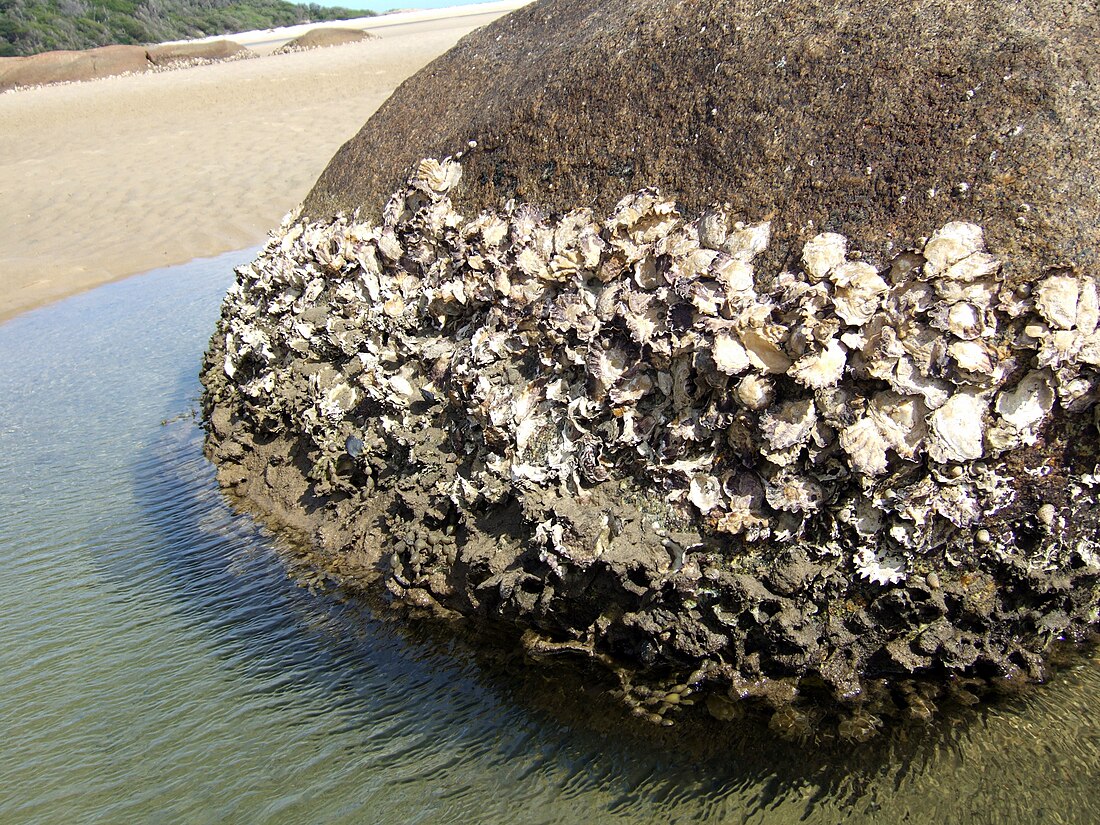Top Qs
Timeline
Chat
Perspective
Saccostrea glomerata
Species of bivalve From Wikipedia, the free encyclopedia
Remove ads
Saccostrea glomerata is an oyster species belonging to the family Ostreidae.[5]
It is endemic to Australia and New Zealand.[6][7] In Australia, it is known as the Sydney rock oyster and is commercially farmed. In New Zealand, where the species is no longer farmed, it is known as the New Zealand rock oyster or Auckland oyster.
Remove ads
Taxonomy
The Sydney rock oyster and New Zealand rock oyster have previously been classified as two separate species: Saccostrea commercialis and S. glomerata, respectively.[8] These species have also been grouped with the hooded oyster into a single species, S. cucullata.[a][b] The species is currently considered to be closely related to S. cucullata, which is common on Indo-Pacific rocky shores.[10]
When proposing the name Ostrea commercialis in 1933, Iredale & Roughley noted that the New South Wales oyster had been variously referred to species O. cucullata Born (Ascension Island), O. mordax Gould (Fiji), O. glomerata Gould (New Zealand), O. circumsuta Gould (Fiji); and even to O. trigonata Sowerby and O. mytiloides Lamarck.[3]
Remove ads
Distribution
In Australia it is found in bays, inlets and sheltered estuaries from Wingan Inlet in eastern Victoria, along the east coast of New South Wales, and north to Hervey Bay, Queensland, around northern Australia and south along the west coast to Shark Bay in Western Australia.[6][7] The spat for these oysters travels down the east coast of Australia on the East Australia Current. Also, a small population exists on the islands in the Furneaux archipelago in Bass Strait, and in Albany on the south west coast of Western Australia, where they are farmed.
Remove ads
Ecology
Sydney rock oysters are capable of tolerating a wide range of salinities. They are usually found in the intertidal zone to 3 m (9.8 ft) below the low-water mark.
Oysters are filter feeders, straining planktonic algae from the water. Birds, fish, stingrays, mud crabs, and starfish all eat Sydney rock oysters, with the Australian pied oystercatcher (Haematopus longirostris) being particularly fond of them.[citation needed]
Selective breeding of farmed rock oysters has successfully bred for disease resistance to two protozoan diseases of oysters, namely, QX disease Marteilia sydneyi and winter mortality Bonamia roughleyi.[citation needed]
Growth and reproduction
Sydney rock oysters are "broadcast spawners", that is, eggs and sperm are released into open water where fertilisation occurs. Within hours of fertilisation, the eggs develop into free-swimming planktonic larvae. The larvae swim in estuarine and coastal waters for up to three weeks, during which they develop transparent shells and retractable feet. The larvae then settle on clean substrates using their feet to find suitable sites. The larval foot is resaborbed once the larva is attached. The shell darkens and the small animal takes on the appearance of an adult oyster.
Growth rates vary with local conditions, but they generally reach 50 g (1.8 oz) in three years. Sydney rock oysters may change sex during life. Many individuals start out as males and later change to females. About 60% of prime eating oysters are female. Selective breeding has reduced the time to market size from three to two years.[11]
Remove ads
Human use
Commercial aquaculture industry

A substantial commercial oyster farming industry is found in New South Wales and southern Queensland, with a small, emerging industry in Albany, Western Australia.[6] The industry produces a gourmet product and provides employment in isolated coastal communities. In Australia, oysters in peak flesh condition (i.e. spawning condition) are preferred for the half-shell trade. The species was once extensively farmed in the Georges River estuary, but has not been since 2023.[12]
The species was once farmed in New Zealand. Oyster farmers there switched to Pacific Oysters, after faster-growing wild Pacific Oysters largely took over the fishery.[13][14][15]
Consumption
Sydney rock oysters are best consumed when freshly shucked, but do have a good shelf life when kept whole. Unopened oysters can remain alive, ready to be shucked, for up to 14 days, provided they are kept at the correct temperature (10 to 20°C) and handled safely. Live Sydney rock oysters should not be placed on ice, until shucked for consumption.[16][17]
Remove ads
Notes
- For example, Harry's 1985 taxonomy, which was based on soft-tissue anatomy as well as shell morphology, only recognised two Saccostrea species: S. cucullata and S. palmula.
Remove ads
References
External links
Wikiwand - on
Seamless Wikipedia browsing. On steroids.
Remove ads

